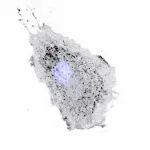Using ultra-low temperatures to understand high-temperature superconductivity
A surprising discovery at TU Wien could help solve the riddle of high-temperature superconductivity: A famous "strange metal" turned out to be a superconductor.
2021-07-21
(Press-News.org) At low temperatures, certain materials lose their electrical resistance and conduct electricity without any loss - this phenomenon of superconductivity has been known since 1911, but it is still not fully understood. And that is a pity, because finding a material that would still have superconducting properties even at high temperatures would probably trigger a technological revolution.
A discovery made at TU Wien (Vienna) could be an important step in this direction: A team of solid-state physicists studied an unusual material - a so-called "strange metal" made of ytterbium, rhodium and silicon. Strange metals show an unusual relationship between electrical resistance and temperature. In the case of this material, this correlation can be seen in a particularly wide temperature range, and the underlying mechanism is known. Contrary to previous assumptions, it now turns out that this material is also a superconductor and that superconductivity is closely related to strange metal behaviour. This could be the key to understanding high-temperature superconductivity in other classes of materials as well.
Strange metal: linear relationship between resistance and temperature
In ordinary metals, electrical resistance at low temperatures increases with the square of the temperature. In some high-temperature superconductors, however, the situation is completely different: at low temperatures, below the so-called superconducting transition temperature, they show no electrical resistance at all, and above this temperature the resistance increases linearly instead of quadratically with temperature. This is what defines "strange metals".
"It has therefore already been suspected in recent years that this linear relationship between resistance and temperature is of great importance for superconductivity," says Prof. Silke Bühler-Paschen, who heads the research area "Quantum Materials" at the Institute of Solid State Physics at TU Wien. "But unfortunately, until now we didn't know of a suitable material to study this in great depth." In the case of high-temperature superconductors, the linear relationship between temperature and resistance is usually only detectable in a relatively small temperature range, and, furthermore, various effects that inevitably occur at higher temperatures can influence this relationship in complicated ways.
Many experiments have already been carried out with an exotic material (YbRh2Si2) that displays strange metal behaviour over an extremely wide temperature range - but, surprisingly, no superconductivity seemed to emerge from this extreme "strange metal" state. "Theoretical considerations have already been put forward to justify why superconductivity is simply not possible here," says Silke Bühler-Paschen. "Nevertheless, we decided to take another look at this material."
Record-breaking temperatures
At TU Wien, a particularly powerful low-temperature laboratory is available. "There we can study materials under more extreme conditions than other research groups have been able to do so far," explains Silke Bühler-Paschen. First, the team was able to show that in YbRh2Si2 the linear relationship between resistance and temperature exists in an even larger temperature range than previously thought - and then they made the key discovery: at extremely low temperatures of only one millikelvin, the strange metal turns into a superconductor.
"This makes our material ideally suited for finding out in what way the strange metal behaviour leads to superconductivity," says Silke Bühler-Paschen.
Paradoxically, the very fact that the material only becomes superconducting at very low temperatures ensures that it can be used to study high-temperature superconductivity particularly well: "The mechanisms that lead to superconductivity are visible particularly well at these extremely low temperatures because they are not overlaid by other effects in this regime. In our material, this is the localisation of some of the conduction electrons at a quantum critical point. There are indications that a similar mechanism may also be responsible for the behaviour of high-temperature superconductors such as the famous cuprates," says Silke Bühler-Paschen.
INFORMATION:
Contact
Prof. Silke Bühler-Paschen
Institute for Solid State Physics
TU Wien
+43-1-58801-13716
silke.buehler-paschen@tuwien.ac.at
[Attachments] See images for this press release:

ELSE PRESS RELEASES FROM THIS DATE:
2021-07-21
A protein involved in making cells move offers a clue to how certain types of cancer metastasize and develop into secondary tumours, according to new research from the University of Warwick.
Scientists from Warwick Medical School have demonstrated for the first time that levels of this protein can increase and decrease the movement of a cell, including cancer cells - suggesting that they could play a role in the spread of tumours.
The study is published today (21 July) in the Journal of Cell Biology and was funded by the Medical Research Council, part of UK Research and Innovation.
The researchers are investigating a tiny cell component called an Intracellular nanovesicle (INV) which acts like a courier within a cell by transporting cargo to where it ...
2021-07-21
Classical molecular sieve membranes, with 3D microparticles and 2D nanosheets as primary building blocks, are promising in chemical separation.
Separation within such membranes relies on molecular movement and transport though their intrinsic or artificial nanopores. Since the weak connections by nature between the neighboring "bricks" usually result in intercrystalline gaps in membranes, the prevailing selectivity for classical molecular sieve membranes is moderate.
Recently, a research group led by Prof. YANG Weishen and Dr. BAN Yujie from the Dalian Institute of Chemical Physics (DICP) of the Chinese Academy of Sciences (CAS) proposed ...
2021-07-21
Professors at Ural Federal University (UrFU, Russia) Sergey Shcheklein and Aleksey Dubinin have developed a technology for generating energy for an electric car engine using methanol. An article describing the technology was published in the International Journal of Hydrogen Energy.
"We pour methanol into the fuel tank. An air converter, which processes methanol into a gas mixture, is installed directly inside the vehicle. A mixture or synthesis gas, consisting of hydrogen and carbon monoxide, is formed in a small volume, which is necessary for the current operation of an electric vehicle engine," said Sergey Shcheklein, head ...
2021-07-21
According to the latest cosmological models, large spiral galaxies such as the Milky Way grew by absorbing smaller galaxies, by a sort of galactic cannibalism. Evidence for this is given by very large structures, the tidal stellar streams, which are observed around them, which are the remains of these satellite galaxies. But the full histories of the majority of these cases are hard to study, because these flows of stars are very faint, and only the remains of the most recent mergers have been detected.
A study led by the Instituto de Astrofísica de Andalucía (IAA-CSIC), with the participation of the Instituto de Astrofísica ...
2021-07-21
Pregnancy-induced diabetes, also known as gestational diabetes, is a common metabolic complication of pregnancy. The disorder carries a significant risk of adverse obstetric outcome. Additionally, it is associated with a high risk of recurrence, progression to maternal type 2 diabetes as well as an elevated risk of obesity in foetuses exposed to hyperglycaemia during gestation.
The mechanisms causing gestational diabetes are complex and incompletely understood. The disorder has a strong underlying genetic element that interacts with lifestyle factors and the physiologic changes accompanying pregnancy to alter maternal glucose regulation.
A team of researchers from the Faculty ...
2021-07-21
The tiny organisms living in soil may have a greater effect on the yield and pest and disease resistance of crop plants grown in that soil than previously known.
Researchers at North Carolina State University and the University of Kansas have shown that soil microbes - microscopic organisms like viruses, bacteria and fungi found throughout nature - play a role in the phenomenon of heterosis or "hybrid vigor," the superior performance of crossed plant lines, or hybrids, over inbred plant lines. Hybrids are often used by farmers for agricultural production due their superior crop yields.
Research into hybrid vigor has generally highlighted the roles of genetic ...
2021-07-21
BOSTON - A new study by research, quality improvement and health equity experts at Massachusetts General Hospital (MGH) in The American Journal of Managed Care lays out the challenges of achieving equity for diverse patients in communication at hospital discharge. A survey of 224 recently discharged patients was conducted in five languages just before the COVID-19 pandemic and highlighted challenges, including limited understanding of medications; lack of available professional medical interpreters and translated patient instructions at discharge; and worries about support for at home after hospitalization.
Major findings include:
Overall, one in four patients were alone at discharge, without a family member ...
2021-07-21
In the context of meditation practice, meditators can experience a state of "pure awareness" or "pure consciousness", in which they perceive consciousness itself. This state can be experienced in various ways, but evidently incorporates specific sensations as well as non-specific accompanying perceptions, feelings, and thoughts. These are just some of the findings of the most extensive survey of meditators ever conducted on the experience of pure consciousness. The findings of the survey recently have been published in PLOS ONE. The study was conducted by Professor Thomas Metzinger from the Department of Philosophy at Johannes Gutenberg University Mainz (JGU) and Dr. Alex Gamma from the Psychiatric ...
2021-07-21
TORONTO, ON - Researchers at the University of Toronto have developed an innovative tool to aid in the investigation of how we perceive and remember visual experiences.
The new tool, referred to as a "scene wheel," will help researchers study how accurately we construct mental representations of visual experiences for later retrieval -- for example, how well an eyewitness recalls details of a crime or accident.
"We know that eyewitness testimony is not reliable," says Gaeun Son. "With the new scene wheel, we can start to characterize the specific nature of those memory failures."
Son is a PhD student in the Faculty of Arts & Science's Department of Psychology and lead ...
2021-07-21
A new study from Oregon State University found that infants born within 3 kilometers of oil and natural gas drilling facilities in Texas had slightly lower birthweights than those born before drilling began in their vicinity.
The study, published today in the journal Environmental Health Perspectives, found that the type of drilling or resource being extracted did not change the result.
"Most studies to date focus exclusively on unconventional natural gas drilling, or fracking. That particular process is a small subset of the oil and natural gas industry. ...
LAST 30 PRESS RELEASES:
[Press-News.org] Using ultra-low temperatures to understand high-temperature superconductivity
A surprising discovery at TU Wien could help solve the riddle of high-temperature superconductivity: A famous "strange metal" turned out to be a superconductor.



